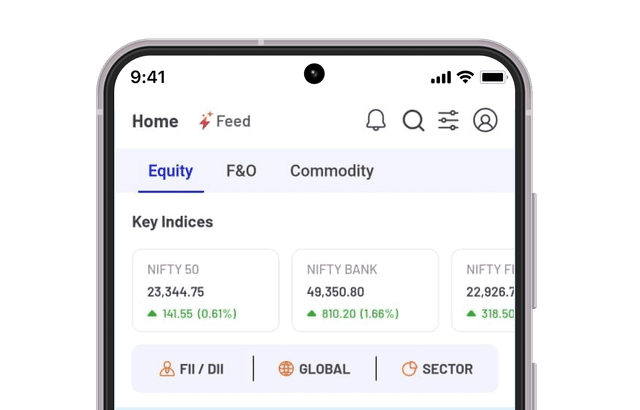Weekly breakout stocks
Last updated on: December 30, 2025
Weekly breakout stocks are stocks with significant price movements or breakouts within a weekly timeframe, signalling a potential shift in market sentiment and investor interest. They are identified through technical analysis, volume confirmation, market sentiment, risk, volatility, and trading strategies. Traders often consult the weekly breakout stock list to identify potential candidates for short-term trading opportunities. They must monitor and adapt their strategies based on evolving market conditions and risk-reward profiles.
5,167.20 | 109497.30 | 409.04 | 3285.33 | |
709.20 | 25010.51 | 244.02 | 2294.01 | |
900 | 16571.12 | 276.49 | 3467.02 | |
28.98 | 222.08 | -0.56 | 44.45 | |
3.45 | 54.30 | 164.22 | 234.39 | |
128.10 | 2660.17 | 1.92 | 362.63 | |
290.55 | 644.68 | -16.89 | 69.34 | |
6,164.50 | 18106.97 | 182.37 | 1551.85 | |
473 | 5582.49 | 9.86 | 1102.7 | |
18.50 | 2356.73 | -105.25 | 1157.19 | |
18,931.80 | 25021.72 | 350.7 | 2081.4 | |
993 | 620754.79 | 4947.76 | 19867.45 | |
420 | 8741.42 | 53.89 | 1670.76 | |
677.55 | 9730.11 | 138.9 | 1031.36 | |
1,646 | 18434.26 | -17.82 | 96.77 | |
3,913.90 | 16941.35 | 107.15 | 4042.41 | |
935 | 12078.38 | 13.9 | 801.33 | |
1,861.40 | 15503.41 | 48.03 | 839.09 | |
395 | 287566.70 | 1278.42 | 5792.09 | |
89.98 | 2229.52 | 40.45 | 325.1 | |
7.65 | 24.00 | -0.81 | - | |
138.20 | 414.60 | 0.71 | 176.07 | |
1,558 | 35587.81 | 98.78 | 2422.37 | |
12,129.90 | 1755.51 | 12.2 | 103.7 | |
58.19 | 290.38 | -0.19 | 19.84 | |
296.30 | 997.16 | 0.74 | 271.33 | |
167.80 | 21838.77 | 445 | 5267 | |
475 | 19039.00 | 648.75 | 6412.76 | |
360.05 | 30753.00 | 173.64 | 4364.51 | |
1,495 | 120713.33 | 1353.07 | 7447.42 |
5,167.20 | |
709.20 | |
900 | |
28.98 | |
3.45 | |
128.10 | |
290.55 | |
6,164.50 | |
473 | |
18.50 | |
18,931.80 | |
993 | |
420 | |
677.55 | |
1,646 | |
3,913.90 | |
935 | |
1,861.40 | |
395 | |
89.98 | |
7.65 | |
138.20 | |
1,558 | |
12,129.90 | |
58.19 | |
296.30 | |
167.80 | |
475 | |
360.05 | |
1,495 |
About Positive Breakout Stocks
Weekly breakout stocks are stocks that experience a significant price increase within a week, often breaking out of their usual range. These stocks are often chosen for quick profits or to demonstrate a company's success. Traders must carefully monitor these stocks, considering factors such as market trends, company performance, and trading volume. However, these price jumps can be short-lived or not always accurate, so traders must manage their risks and make their trades at the right time. Analysing patterns in weekly breakout Indian stocks can provide valuable insights for investors seeking potential trading opportunities. To effectively trade breakout stocks, traders must combine market behaviour, company information, and risk management. They are closely monitoring the market for one week breakout stocks to capitalise on short-term gains.
How to Identify Weekly Breakout Stocks?
- Start by identifying a market with clearly defined support or resistance levels. The more times a stock bounces off these levels, the stronger the signal.
- Consolidation occurs when a market becomes caught in a channel between clearly defined support and resistance levels. Various patterns inside a consolidation, such as head and shoulders, triangles, or flags, might suggest an impending breakout.
- Longer periods of consolidation are frequently connected with larger breakouts. A stock that has traded inside a specific range for an extended period of time is more likely to make a large move than one that has just been consolidating for a few weeks.
Advantages & Disadvantages of Weekly Breakout Stocks
The advantages and disadvantages of weekly breakout stocks are presented below in a table.
| Advantages of Weekly Breakout Stocks | Disadvantages of Weekly Breakout Stocks |
| Potential for quick profits | False breakouts can lead to losses |
| Opportunity to catch emerging trends | Requires constant monitoring |
| Provides clear entry and exit points | Higher risk due to short-term volatility |
| Accessible to short-term traders | Limited success in choppy markets |
This format provides a structured highlighting of key points for traders and investors to consider.
Why are Weekly Stock Breakouts Important?
Traders and active investors utilise breakouts to spot emerging trends. They are frequently followed by price movement and increased volatility, making them an ideal environment for finding profitable chances.
Imagine there's a company whose stock price often reaches Rs. 100 but then falls back down. Because this happens so frequently, investors might be cautious about buying the stock at Rs. 100, thinking they won't make much profit.
However, if the stock price finally goes above Rs. 100, investors may see this as a good sign to buy the stock. At the same time, people who bet against the stock (short sellers) might decide to buy it to avoid losing more money. This increased buying can push the stock price even higher.
